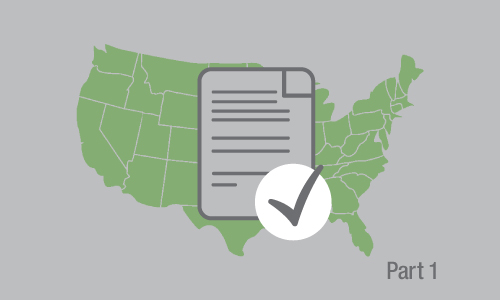The Clean Air Act is a complicated set of rules and regulations that affect the way that we commute, produce, and operate businesses across the United States. With so many moving parts and enforcement activities, the process for remaining compliant with location-based NAAQS is challenging for many areas, and it’s on the states to develop plans and initiatives to improve air quality.
As we discussed in our last blog, there are currently seven areas that failed to maintain their classification as “moderate” nonattainment areas for Ozone, as dictated by the 2008 Ozone National Ambient Air Quality Standards (NAAQS). With 2015 NAAQS set to push the limits even lower, the seven areas likely to be classified as “Serious” nonattainment areas face more stringent requirements to maintain or possibly improve their nonattainment status.
Today, we will look at the process of drafting a State Implementation Plan, discuss requirements for states to develop these plans, compare EPA expectations for each level of nonattainment, and explore potential impacts on manufacturers in the affected communities.
State Implementation Plans: Built from NAAQS
The development and implementation of State Implementation Plans come from the concept of National Ambient Air Quality Standards (NAAQS). Under the Clean Air Act, the Federal EPA has authority to establish NAAQS for six pollutants and develop other regulations through the rulemaking process, reviewing the standards every five years.
The Air Quality Management Cycle
This process follows the “Air Quality Management Cycle,” a five-step process built on establishing goals, determining reductions, developing control strategies, implementing programs, and re-evaluating effectiveness. Per the EPA website:
- Establish Goals and Determine Nonattainment: A government institution typically establishes goalsrelated to air quality. An example is an acceptable level of a pollutant in the air that will protect public health, including people who are more vulnerable to the effects of air pollution.
- Determine Reductions and Develop Plans: Air quality managers need to determinehow much emissions reductions are needed to achieve the goal. Air quality managers use emissions inventories, air monitoring, air quality modeling and other assessment tools to understand the air quality problem fully.
- Develop Control Strategies, EPA Approves/Denies Plan: With approval and feedback from the EPA, states develop control strategies, a process in which air quality managers consider how pollution prevention and emission control techniques can be applied to achieve the reductions needed to achieve the goals.
- States Implement Plans: To successfully achieve the air quality goals, air quality managers need to implement programs for pollution control strategies. Regulations or incentive programs that lower emissions from sources need to be put in place. Regulated industries need training and assistance in how to comply with rules. And the rules need to be enforced.
- Evaluate and Revise: It is important to undertake on-going evaluation to know if your air quality goals are being met. Evaluation takes place on an ongoing basis and the process starts again.
Each process takes into consideration scientific input and research to provide air quality managers with essential understanding of how pollutants are emitted, transported and transformed in the air and their effects on human health and the environment.
Developing and Implementing State Implementation Plans
After establishing goals, it becomes the responsibility of the states to develop a plan to achieve it. This process makes much more sense than a federal edict, as it takes into consideration local concerns, needs, and input to provide a more reliable and tailored approach to reducing pollutants (see where to find your state implementation plan and responsible department, and resources in each state here).
Designation
With NAAQS determined, the SIP development process can begin. EPA must first identify or “designate” areas as meeting (attainment areas) or not meeting (nonattainment areas), the standards. Nonattainment areas are determined using EPA design value, a statistic used to determine severity.
Infrastructure SIP Submission
Secondly, states must prove they have the management program components in place, referred to as “infrastructure SIPs.” View State Infrastructure Reports and Approval Status here.
SIP Submission and Approval/Disapproval
After reviewing submitted SIPs, EPA proposes to approve or disapprove all or part of each plan. Following a comment period, the EPA takes final action on a plan, approving all or part of a plan.
If EPA approves all or part of a SIP, those control measures are enforceable in federal court. If a state fails to submit an approvable plan or if EPA disapproves a plan, EPA is required to develop a federal implementation plan (FIP).
Your Path to Compliance
In the coming weeks, we will continue to discuss the development, execution, and enforcement of State Implementation Plans, discussing more on the state roles in the process and the changes that may come both from current nonattainment or pending regulations (i.e. the 2015 Ozone Standard set to take effect in the coming years).
While SIPs cover a wide variety of processes ranging from transportation to manufacturing, recent news has placed manufacturers in the spotlight. At The CMM Group, we can help you to develop a plan at your own facility to reduce emissions and implement strategies, processes, and emission control equipment that can help you meet or exceed current standards. Stay tuned for part two of our series, learn more about our work, download our VOC Abatement Guide, and contact us for more information.




